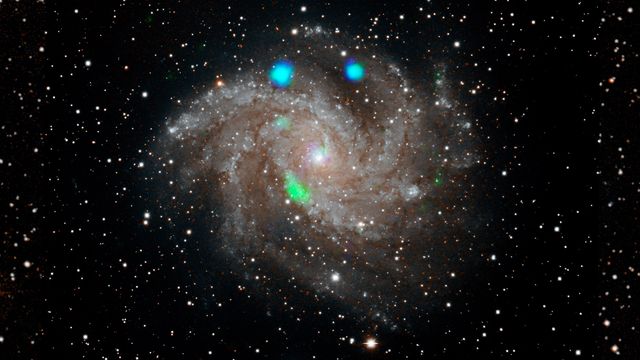- The colored blobs in the picture above were not added. They're called ULXs, but NASA doesn't know where they came from.
- Maybe the ULXs came from either a black hole's accretion disk, or a wavering in a neutron star's magnetic fields.
- Scientists plan on studying the phenomena further.
While studying a supernova in the distant Fireworks galaxy (NGC 6946), a NASA space observatory has observed extremely bright sources of X-ray light that resulted in dazzling flashes of blue and green. The appearance surprised scientists, who called the lights a "mystery."
The 772-pound NuSTAR (Nuclear Spectroscopic Telescope Array) mission was first deployed in 2012 with the goal of observing the "high-energy X-rays more closely, in higher resolution, than any space telescope before it."
Now focused on some of the most energetic processes in the universe, for short periods of time a supernova can generate enough visible light to outshine entire galaxies made up of billions of stars. Supernovas are crucial to the continued existence of the universe, as they create many chemical materials heavier than iron.
It's a transition worthy of intense study, but here's the thing: When the NuSTAR began monitoring the supernova, the green blob near the bottom of the galaxy wasn't visible. It only emerged on the 10th day of study. Another NASA telescope was able to confirm that the green blob had dissolved as soon as it appeared.
Scientists have seen this type of phenomena before, but they're extremely rare. They're called ultra-luminous X-ray sources, or ULXs. This one is named ULX-4, because it's only the fourth one ever observed in the Milky Way galaxy.
"Ten days is a really short amount of time for such a bright object to appear," says Hannah Earnshaw, a postdoctoral researcher at Caltech in Pasadena, California, and lead author on the new study, in a press statement. "Usually with NuSTAR, we observe more gradual changes over time, and we don't often observe a source multiple times in quick succession. In this instance, we were fortunate to catch a source changing extremely quickly, which is very exciting."
So what caused the colors? Nobody is sure, but scientists posit in their latest study that it could be light generated from the accretion disk of a black hole. Accretion disks are a traffic jams built into black holes. They pull in matter so quickly that there's not enough space for it all, so the waiting matter spins around the black hole at such speeds that it illuminates a bright whiteness.
Most ULXs are long-lived, but this one was quick. So it's possible that it was triggered by a quick event—something like a black hole destroying a nearby small star.
But that's just one idea. Another, according to the paper's authors, it that the source of ULX-4 could be a neutron star. As some of the densest objects in the universe, neutron stars are formed when a star's explosion doesn't generate enough energy for a black hole. But, like black holes, they can create accretion disks.
Neutron stars generate magnetic fields of tremendous strength, strong enough "that the very atoms are stretched out into cylinders along the field line," according to Cole Miller, of the University of Maryland's Department of Astronomy. The fields have the strength to generate what are called "columns" that push material down to the surface.
These magnetic columns and accretion disks are set up for a galactic battle. The disks are getting pulled into the neutron star's gravity, which the magnetic columns will repel.
"It would kind of be like trying to jump onto a carousel that's spinning at thousands of miles per hour," Earnshaw says.
But, the team says, it's possible that the magnetic columns might have wavered for some unknown reason, and that wavering would allow some material to break through.
"This result is a step towards understanding some of the rarer and more extreme cases in which matter accretes onto black holes or neutron stars," Earnshaw says.
David Grossman is a staff writer for PopularMechanics.com. He's previously written for The Verge, Rolling Stone, The New Republic and several other publications. He's based out of Brooklyn.














